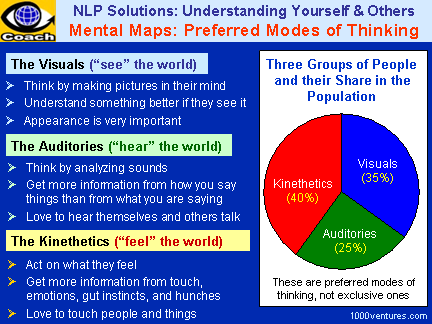
|
Myers-Briggs Type
Indicator (MBTI) |
|
Perception:
What You Pay Attention To |
|
Senser (S) |
Intuiter (N) |
|
The 5 senses |
Intuition
(the 6th sense) |
|
Practical, facts |
Theoretical, insights |
|
Present, what is real |
Future, what could be |
|
Using established
skills |
→
Learning new skills |
|
Utility, step by step |
Novelty,
→
radical change |
|
Information:
How You Make Decisions |
|
Thinker (T) |
Feeler (F) |
|
Head, reason,
→
principles |
Heart,
→
empathy
,
harmony |
|
Logical system |
Value system |
|
Objective |
Subjective |
|
Justice, critique |
Mercy, compliment |
|
Firm but fair |
Compassionate |
|
Face the Reality
→
Same Reality,
Different Perceptions
There are many models for understanding and
characterizing
the styles
of interaction different people prefer to employ. Different people take
in the world through different senses – seeing, hearing, or feeling it.
Further, different people tend to lead their decision-making process with
one of the four functions:
→
thinking
 , feeling,
intuition, and
sensing. Vividly
→
differentiated
differences that are anchored to a product and engage the above functions
can
enhance memory of your current and prospective
customers. , feeling,
intuition, and
sensing. Vividly
→
differentiated
differences that are anchored to a product and engage the above functions
can
enhance memory of your current and prospective
customers.
→
Customer
Value Proposition
→
Focus on
Emotional Drivers
→
Sell
Benefits
Connect with Senses
People have three basic methods of
perceiving the
world around them:
Individuals have
different preferred ways of thinking and communicating their experiences
– some express themselves in pictures, others talk about how things sound to
them, and others speak about how things feel. If you want to connect with
your target customers, you have to:
 Marketing e-Courses Marketing e-Courses
E-sales of the
Business Guru for trainers rose by 30% within a week after the
description of the product at the buy-now page was changed from "training
course" to
"training course with 200 slides". Apart from communicating the
simplicity and easy delivery of the material, the word "slides" established
quick connection with the visuals reading the description.
→
Your
People Skills 360

→
Customer Success 360

Help Different Types of
People Solve Their Problems
→
Selling Is
Problem Solving
Different people pay attention to different
things and apply different criteria for making decisions. When people
→
solve problems
 , the four functions - feeling, sensing, thinking, and
intuition – come into play in
different combinations. The
Myers-Briggs Type Indicator
(MBTI) is a widely used approach for understanding and characterizing the
styles of interaction different people prefer to employ. It is based, in
particular, on the following dimensions of a person's preferred approach to
→
life. , the four functions - feeling, sensing, thinking, and
intuition – come into play in
different combinations. The
Myers-Briggs Type Indicator
(MBTI) is a widely used approach for understanding and characterizing the
styles of interaction different people prefer to employ. It is based, in
particular, on the following dimensions of a person's preferred approach to
→
life.
"People often are a mixture of these functions.
"Intuiters" and "Feelers" both tend to dislike too much detail. "Thinkers"
and "Sensors" work with more information. But they all are trying to make a
decision on what to buy, one way or another."1
Let's look at these functions from a
→
selling
point of view. |